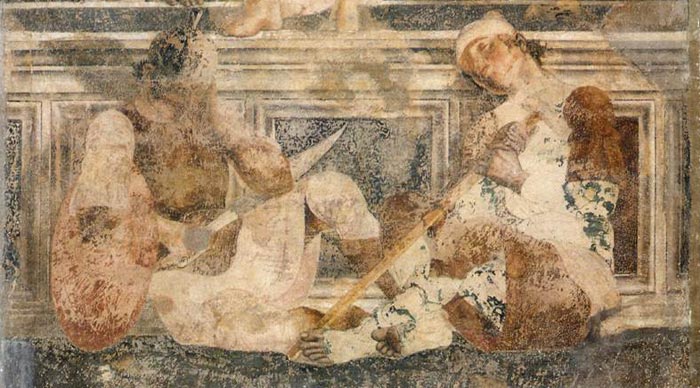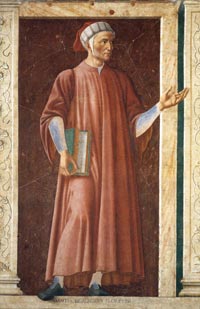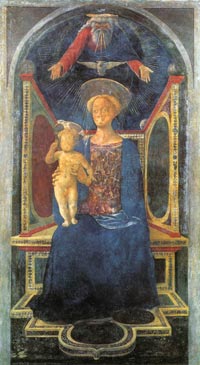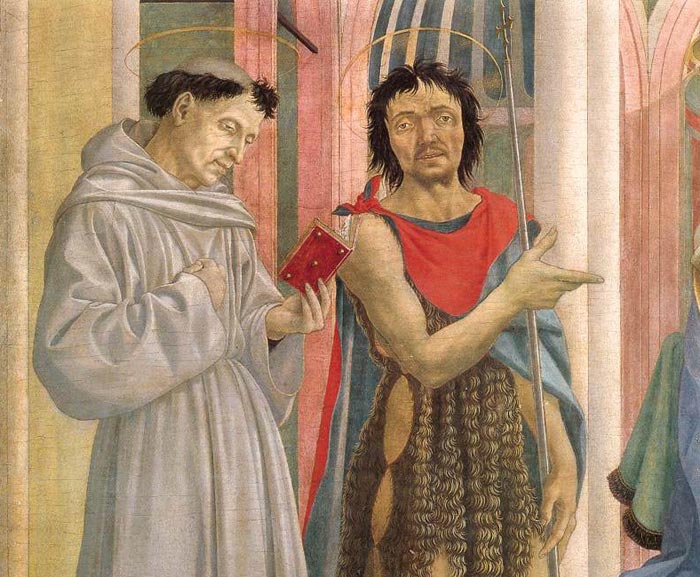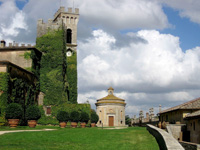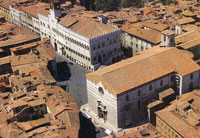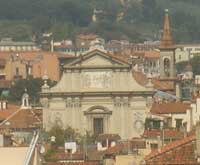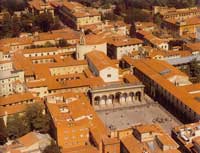|
| How reprehensible is the vice of envy, which should never exist in anyone, when found in a man of excellence, and how wicked and horrible a thing it is to seek under the guise of a feigned friendship to extinguish not only the fame and glory of another but his very life, I truly believe it to be impossible to express with words, for the wickedness of the act overcomes all power and force of speech, however eloquent. For this reason, without enlarging further on this subject, I will only say that in such men there dwells a spirit not merely inhuman and savage but wholly cruel and devilish, and so far removed from any sort of virtue that they are no longer men or even animals, and do not deserve to live. For even as emulation and rivalry, when men seek by honest endeavour to vanquish and surpass those greater than themselves in order to acquire glory and honour, are things worthy to be praised and to be held in esteem as necessary and useful to the world, so, on the contrary, the wickedness of envy deserves a proportionately greater meed of blame and vituperation, when, being unable to endure the honour and esteem of others, it sets to work to deprive of life those whom it cannot despoil of glory; as did that miserable Andrea dal Castagno, who was truly great and excellent in painting and design, but even more notable for the rancour and envy that he bore towards other painters, insomuch that with the blackness of his crime he concealed and obscured the splendour of his talents. This man, having been born at a small village called Castagno in Mugello, in the territory of Florence, took that name as his own surname[Pg 98] when he came to live in Florence, which came about in the following manner. Having been left without a father in his earliest childhood, he was adopted by an uncle, who employed him for many years in watching his herds, since he saw him to be very ready and alert, and so masterful, that he could look after not only his cattle but the pastures and everything else that touched his own interest. Now, while he was following this calling, it came to pass one day that he chanced to seek shelter from the rain in a place wherein one of those local painters, who work for small prices, was painting a shrine for a peasant. Whereupon Andrea, who had never seen anything of the kind before, was seized by a sudden marvel and began to look most intently at the work and to study its manner; and there came to him on the spot a very great desire and so violent a love for that art, that without losing time he began to scratch drawings of animals and figures on walls and stones with pieces of charcoal or with the point of his knife, in so masterly a manner that it caused no small marvel to all who saw them. The fame of this new study of Andrea's then began to spread among the peasants; whereupon, as his good-fortune would have it, the matter coming to the ears of a Florentine gentleman named Bernardetto de' Medici, whose possessions were in that district, he expressed a wish to know the boy; and finally, having seen him and having heard him discourse with great readiness, he asked him whether he would like to learn the art of painting. Andrea answered that nothing could happen to him that would be more welcome or more pleasing than this, and Bernardetto took the boy with him to Florence, to the end that he might become perfect in that art, and set him to work with one of those masters who were then esteemed the best. |
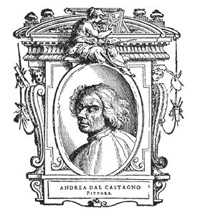 |
|
||
Andrea del Castagno, Last Supper |
||
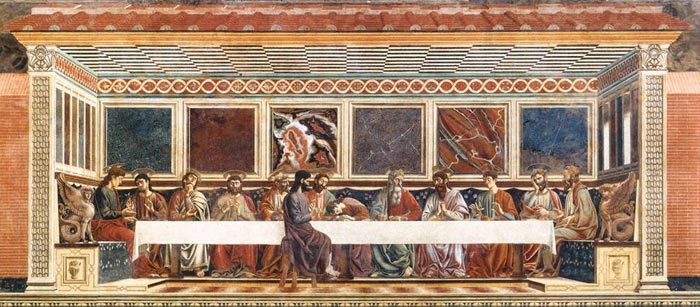 |
||
| Thereupon Andrea, following the art of painting and devoting himself heart and soul to its studies, displayed very great intelligence in the difficulties of that art, above all in draughtsmanship. But he was not so successful in the colouring of his works, which he made somewhat crude and harsh, thus impairing to a great extent their excellence and grace, and depriving them, above all, of a certain quality of loveliness, which is not found in his colouring. He showed very great boldness in the[Pg 99] movements of his figures and much vehemence in the heads both of men and of women, making them grave in aspect and excellent in draughtsmanship. There are works coloured in fresco, painted by his hand in his early youth, in the cloister of S. Miniato al Monte as one descends from the church to go into the convent, including a story of S. Miniato and S. Cresci leaving their father and mother. In S. Benedetto, a most beautiful monastery without the Porta a Pinti, both in a cloister and in the church, there were many pictures by the hand of Andrea, of which there is no need to make mention, since they were thrown to the ground in the siege of Florence. Within the city, in the first cloister of the Monastery of the Monks of the Angeli, opposite to the principal door, he painted the Crucifix that is still there to-day, with the Madonna, S. John, S. Benedict, and S. Romualdo; and at the head of the cloister, which is above the garden, he made another like it, only varying the heads and a few other details. In S. Trinita, beside the Chapel of Maestro Luca, he painted a S. Andrew. In a hall at Legnaia he painted many illustrious men for Pandolfo Pandolfini; and a standard to be borne in processions, which is held very beautiful, for the Company of the Evangelist.
In certain chapels of the Church of the Servi in the said city he wrought three flat niches in fresco. In one of these, that of S. Giuliano, there are scenes from the life of that Saint, with a good number of figures, and a dog in foreshortening that was much extolled. Above this, in the chapel dedicated to S. Girolamo, he painted that Saint shaven and wasted away, with good design and great diligence. Over this he painted a Trinity, with a Crucifix so well foreshortened that Andrea deserves to be greatly extolled for it, seeing that he executed the foreshortenings with a much better and more modern manner than the others before him had shown; but this picture, having been afterwards covered with a panel by the family of the Montaguti, can no longer be seen. In the third, which is beside the one below the organ, and which was erected by Messer Orlando de' Medici, he painted Lazarus, Martha, and the Magdalene. For the Nuns of S. Giuliano, over their door, he made a Crucifix in fresco, with a Madonna, a S. Dominic, a S. Julian,[Pg 100] and a S. John; which picture, one of the best that Andrea ever made, is universally praised by all craftsmen. In the Chapel of the Cavalcanti in S. Croce he painted a S. John the Baptist and a S. Francis, which are held to be very good figures. But what caused all the craftsmen to marvel was a very beautiful picture in fresco that he made at the head of the new cloister of the said convent, opposite to the door, of Christ being scourged at the Column, wherein he painted a loggia with columns in perspective, and groined vaulting with diminishing lines, and walls inlaid in a pattern of mandorle, with so much art and so much diligence, that he showed that he had no less knowledge of the difficulties of perspective than he had of design in painting. In the same scene there are beautiful and most animated attitudes in those who are scourging Christ, showing hatred and rage in their faces as clearly as Jesus Christ is showing patience and humility. In the body of Christ, which is bound tightly with ropes to the Column, it appears that Andrea tried to demonstrate the suffering of the flesh, while the Divinity concealed in that body maintains a certain noble splendour, which seems to be moving Pilate, who is seated among his councillors, to seek to find some means of liberating Him. In short, this picture is such that, if the little care that has been taken of it had not allowed it to be scratched and spoilt by children and simpletons, who have scratched all the heads and the arms and almost the entire persons of the Jews, as though they would thus take vengeance on them for the wrongs of Our Lord, it would certainly be the most beautiful of all the works of Andrea. And if Nature had given grace of colouring to this craftsman, even as she gave him invention and design, he would have been held truly marvellous. In S. Maria del Fiore he painted the image of Niccolò da Tolentino on horseback; and while he was working at this a boy who was passing shook his ladder, whereupon he flew into such a rage, like the brutal man that he was, that he jumped down and ran after him as far as the Canto de' Pazzi. In the cemetery of S. Maria Nuova, also, below the Ossa, he painted a S. Andrew, which gave so much satisfaction that he was afterwards commissioned to paint the Last Supper of Christ with His[Pg 101] Apostles in the refectory, where the nurses and other attendants have their meals. Having acquired favour through this work with the house of Portinari and with the Director of the hospital, he was appointed to paint a part of the principal chapel, of which another part was allotted to Alesso Baldovinetti, and the third to the then greatly celebrated painter Domenico da Venezia, who had been summoned to Florence by reason of the new method that he knew of painting in oil. Now, while each of them applied himself to his part of the work, Andrea was very envious of Domenico, because, while knowing himself to be superior to the other in design, he was much displeased that the Venetian, although a foreigner, should be welcomed and entertained by the citizens; wherefore anger and disdain moved him so strongly, that he began to think whether he could not in one way or another remove him from his path. Andrea was no less crafty in dissimulation than he was excellent in painting, being cheerful of countenance at his pleasure, ready of speech, fiery in spirit, and as resolute in every bodily action as he was in mind; he felt towards others as he did towards Domenico, and, if he saw some error in the works of other craftsmen, he was wont to mark it secretly with his nail. And in his youth, when his works were criticized in any respect, he would give the critics to know by means of blows and insults that he was ever able and willing to take revenge in one way or another for any affront. But let us say something of Domenico, before we come to the work of the said chapel. Before coming to Florence, Domenico had painted some pictures with much grace in the Sacristy of S. Maria at Loreto, in company with Piero della Francesca; which pictures, besides what he had wrought in other places (such as an apartment in the house of the Baglioni in Perugia, which is now in ruins), had made his fame known in Florence. Being summoned to that city, before doing anything else, he painted a Madonna in the midst of some saints, in fresco, in a shrine on the Canto de' Carnesecchi, at the corner of two streets, of which one leads to the new Piazza di S. Maria Novella and the other to the old. This work, being approved and greatly extolled by the citizens and by the craftsmen of those times, caused even greater disdain and envy to blaze[Pg 102] up in the accursed mind of Andrea against poor Domenico; wherefore Andrea, having determined to effect by deceit and treachery what he could not carry out openly without manifest peril to himself, pretended to be very much the friend of Domenico, who, being a good and affectionate fellow, fond of singing and devoted to playing on the lute, received him as a friend very willingly, thinking Andrea to be a clever and amusing person. And so, continuing this friendship, so true on one side and so false on the other, they would come together every night to make merry and to serenade their mistresses; and this gave great delight to Domenico, who, loving Andrea sincerely, taught him the method of colouring in oil, which as yet was not known in Tuscany. Andrea, then (to take events in their due order), working on his wall in the Chapel of S. Maria Nuova, painted an Annunciation, which is held very beautiful, for in that work he painted the Angel in the air, which had never been done up to that time. But a much more beautiful work is held to be that wherein he made the Madonna ascending the steps of the Temple, on which he depicted many beggars, and one among them hitting another on the head with a pitcher; and not only that figure but all the others are wondrously beautiful, for he wrought them with much care and love, out of rivalry with Domenico. There is seen, also, in the middle of a square, an octagonal temple drawn in perspective, standing by itself and full of pilasters and niches, with the façade very richly adorned with figures painted to look like marble. Round the square are various very beautiful buildings; and on one side of these there falls the shadow of the temple, caused by the light of the sun—a beautiful conception, carried out with great ingenuity and art. Maestro Domenico, on his part, painting in oil, represented Joachim visiting his consort S. Anna, and below this the Birth of Our Lady, wherein he depicted a very ornate chamber, and a boy beating very gracefully with a hammer on the door of the said chamber. Beneath this he painted the Marriage of the Virgin, with a good number of portraits from the life, among which are those of Messer Bernardetto de' Medici, Constable of the Florentines, wearing a large red barret-cap; Bernardo Guadagni, who was Gonfalonier; Folco Portinari, and others of that[Pg 103] family. He also painted a dwarf breaking a staff, very life-like, and some women wearing garments customary in those times, lovely and graceful beyond belief. But this work remained unfinished, for reasons that will be told below. |
||
|
||
Meanwhile Andrea had painted in oil on his wall the Death of Our Lady, in which, both by reason of his rivalry with Domenico and in order to make himself known for the able master that he truly was, he wrought in foreshortening, with incredible diligence, a bier containing the dead Virgin, which appears to be three braccia in length, although it is not more than one and a half. Round her are the Apostles, wrought in such a manner, that, although there is seen in their faces their joy at seeing their Madonna borne to Heaven by Jesus Christ, there is also seen in them their bitter sorrow at being left on earth without her. Among the Apostles are some angels holding burning lights, with beautiful expressions in their faces, and so well executed that it is seen that he was as well able to manage oil-colours as his rival Domenico. In these pictures Andrea made portraits from life of Messer Rinaldo degli Albizzi, Puccio Pucci, and Falganaccio, who brought about the liberation of Cosimo de' Medici, together with Federigo Malevolti, who held the keys of the Alberghetto. In like manner he portrayed Messer Bernardo di Domenico della Volta, Director of that hospital, who is kneeling and appears to be alive; and in a medallion at the beginning of the work he painted himself with the face of Judas Iscariot, whom he resembled both in appearance and in deed. Now Andrea, having carried this work very nearly to completion, being blinded by envy of the praises that he heard given to the talent of Domenico, determined to remove him from his path; and after having thought of many expedients, he put one of them into execution in the following manner. One summer evening, according to his custom, Domenico took his lute and went forth from S. Maria Nuova, leaving Andrea in his room drawing, for he had refused to accept the invitation to take his recreation with Domenico, under the pretext of having to do certain drawings of importance. Domenico therefore went to take his pleasure by himself, and Andrea set himself to wait for him in hiding[Pg 104] behind a street corner; and when Domenico, on his way home, came up to him, he crushed his lute and his stomach at one and the same time with certain pieces of lead, and then, thinking that he had not yet finished him off, beat him grievously on the head with the same weapons; and finally, leaving him on the ground, he returned to his room in S. Maria Nuova, where he put the door ajar and sat down to his drawing in the manner that he had been left by Domenico. Meanwhile an uproar had arisen, and the servants, hearing of the matter, ran to call Andrea and to give the bad news to the murderer and traitor himself, who, running to where the others were standing round Domenico, was not to be consoled, and kept crying out: "Alas, my brother! Alas, my brother!" Finally Domenico expired in his arms; nor could it be discovered, for all the diligence that was used, who had murdered him; and if Andrea had not revealed the truth in confession on his death-bed, it would not be known now. In S. Miniato fra le Torri in Florence Andrea painted a panel containing the Assumption of Our Lady, with two figures; and in a shrine in the Nave a Lanchetta, without the Porta alla Croce, he painted a Madonna. In the house of the Carducci, now belonging to the Pandolfini, the same man depicted certain famous men, some from imagination and some portrayed from life, among whom are Filippo Spano degli Scolari, Dante, Petrarca, Boccaccio, and others. At Scarperia in Mugello, over the door of the Vicar's Palace, he painted a very beautiful nude figure of Charity, which has since been ruined. In the year 1478, when Giuliano de' Medici was killed and his brother Lorenzo wounded in S. Maria del Fiore by the family of the Pazzi and their adherents and fellow-conspirators, it was ordained by the Signoria that all those who had shared in the plot should be painted as traitors on the wall of the Palace of the Podestà. This work was offered to Andrea, and he, as a servant and debtor of the house of Medici, accepted it very willingly, and, taking it in hand, executed it so beautifully that it was a miracle. It would not be possible to express how much art and judgment were to be seen in those figures, which were for the most part portraits from life, and which were hung up by the feet in strange attitudes, all varied[Pg 105] and very beautiful. This work, which pleased the whole city and particularly all who had understanding in the art of painting, brought it about that from that time onwards he was called no longer Andrea dal Castagno but Andrea degl' Impiccati.[13]
Andrea lived in honourable style, and since he spent his money freely, particularly on dress and on maintaining a fine household, he left little property when he passed to the other life at the age of seventy-one. But since the crime that he had committed against Domenico, who loved him so, became known a short time after his death, it was with shameful obsequies that he was buried in S. Maria Nuova, where, at the age of fifty-six, the unhappy Domenico had also been buried. The work begun by the latter in S. Maria Nuova remained unfinished, nor did he ever complete it, as he had done the panel of the high-altar in S. Lucia de' Bardi, wherein he executed with much diligence a Madonna with the Child in her arms, S. John the Baptist, S. Nicholas, S. Francis, and S. Lucia; which panel he had brought to perfect completion a little before he was murdered.[Pg 106] Disciples of Andrea were Jacopo del Corso, who was a passing good master, Pisanello, Marchino, Piero del Pollaiuolo, and Giovanni da Rovezzano. |
|
|
|
||
Domenico Veneziano, Central panel from Santa Lucia de’ Magnoli Altarpiece (detail), c. 1445, tempera on wood, Galleria degli Uffizi, Florence |
||
[1] 'Considered the first art historian and often referred to as the “father of art history”, Varsari was the son of Antonio Vasari (d. 1527), a potter, and Maddelena Tacci (d. 1558). He learned Latin and other humanist disciplines in the 1520’s by Antonio da Saccone and Giovanni Pollastra (1465–1540). Throughout his career, Vasari practiced as an artist. He entered the Arezzo studio of Guillaume de Marcillat, whose previous commissions at the Vatican in Rome brought Vasari into conversance with the work of Michelangelo and Raphael. Vasari’s own painting led the Cardinal of Cortona, Silvio Passerini (1470–1529), tutor of Alessandro and Ippolito de’ Medici, to take Vasari with him to Florence in 1524. There Vasari and the two Medici received further instruction by Pierio Valeriano (1477–1558). Vasari also trained during this time in the Florentine workshops of Andrea del Sarto and Baccio Bandinelli, under Francesco Salviati. Forced to return to Arezzo when the Medici were expelled in 1527, Vasari entered the service of Cardinal Ippolito de’ Medici in January 1532. He studied ancient and modern Roman art and architecture again with Salviati. There he also met Paolo Giovio, an important force for his Vite years later. When Alessandro de’ Medici was murdered in 1537, Vasari was once again devoid of a princely patron. From that point on, he decided to exist on his own. He painted several work for the monks at Camaldoli before journeying to Rome in 1538, accompanied by his assistant Giovanni Battista Cungi. Already he was interested in studying ancient with a view of their effect on contemporary art, the core idea later into his masterwork of writing, the Vite. Vasari went to Venice in 1541. After about seven years of writing, Vasari published his most famous book, Le vite de più eccellenti architetti, pittori, et scultori in 1550. The printer was the Florentine humanist Lorenzo Torrentino (d. 1563). The two-volume, octavo work was dedicated to Cosimo de’ Medici. After its appearance several other biographies of artists appeared, most notably the life of Michelangelo by Asconio Condivi (q.v.). Vasari corrected and enlarged his text, issuing a second edition in 1568. It is this version that all subsequent editions and translations are based, and for which Vasari owes his fame. The work is divided into a preface (proemio), a discussion of the various media, and then three sections devoted to artist biographies arranged chronologically. When Vasari wrote his lives he was concerned mainly with Florentine artists. The first section covers Cimabue to Lorenzo di Bicci, section two from Jacopo della Quercia to Pietro Perugino, and the final section, from Leonardo da Vinci to Michelangelo. Michelangelo was the only artist still living when the Vite appeared. Vasari ends with a section to ‘artists and readers’. Several indexes complete the work. Chronological biographies of artists had previously existed. Vasari’s contribution was to create a critical, i.e., evaluative, history of artistic style, although he was far from unbiased. Core to Vasari was the notion of the rebirth of art, a rinascita. Art had a history and by new birth, it reestablished itself as a noble pursuit worthy of study. Vasari’s division art history into ages took as its paradigm the stages of human development. This, too, was not a novel conception with Vasari, but in his book, it took on a logical sense of order. Art’s early perfection was the antique, but hade then declined under Constantine. This low period of barbaric or Germanic art (“Gothic” Vasari called it) far removed from classical models, was ready for renaissance. Cimabue, Giotto and others formed the naissance of art, inspired by the imitation of nature, a primary stage (primi lumi). A developmental period (augumento) was ultimately succeeded by the age of perfection (perfezione)--coincidentally Vasari’s own time and that of Michelangelo. Vasari’s book created a sensation. Benvenuto Cellini found much fault, but Michelangelo, Gherardi, Salviati and Carlo Fontana praised it. Vasari wrote a second book, somewhat of a supplement to the Lives, entitled Ragionamenti sopra le Invenzioni. Appearing after his death in 1588, the book is a catalog of the allegorical compositions in the Palazzo Vecchio.' [Sources: Kultermann, Udo. Geschichte der Kunstgeschichte: Der Weg einer Wissenschaft. 2nd ed. Frankfurt am Main and Vienna: Ullstein, 1981, p. 438 n. 9; Blunt, Anthony. Artistic Theory in Italy: 1450-1600. Oxford: Clarendon Press, 1962, pp. 86-102; Kleinbauer, W. Eugene. Modern Perspectives in Western Art History: An Anthology of 20th-Century Writings on the Visual Arts. New York: Holt, Rinehart and Winston, 1971, pp. 68-9; Rud, Einar. Vasari’s Life and Lives: The First Art Historian. Princeton, NJ: Van Nostrand Company, 1963.] |
||||
Art in Tuscany | Giorgio Vasari | Lives of the Most Excellent Painters, Sculptors, and Architects |
||||
Holiday accomodation in Tuscany | Podere Santa Pia | Artist and writer's residency
|
||||
Podere Santa Pia |
Podere Santa Pia, garden view, April |
View from Podere Santa Pia
on the coast and Corsica |
||
Villa Celsa near Florence |
Piazza della Santissima Annunziata in Florence |
Perugia |
||
The façade and the bell tower of San Marco in Florence |
Piazza della Santissima Annunziata in Florence |
Florence, Duomo |
||

